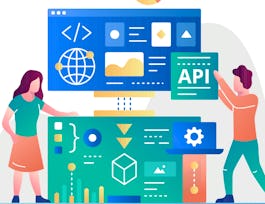This course will teach you how to build RESTful APIs using Node.js and Express, two popular and widely used technologies in web development. You will learn how to create a server-side application that can handle requests from client-side applications and respond with JSON data.



Building RESTful APIs with Node.js and Express
This course is part of Learning MEAN Stack by Building Real world Application Specialization

Instructor: Board Infinity
2,487 already enrolled
Included with
Recommended experience
What you'll learn
Learn Node.js and Express, including setup, server creation, HTTP handling, and middleware application for modern web development.
Acquire skills in MongoDB with Node.js, connecting to databases, performing CRUD operations, and utilizing NoSQL database advantages.
Explore advanced Node.js techniques such as asynchronous programming, error handling, and control flow management for robust apps.
Focus on building scalable, secure web applications with maintainable code, implementing security measures, and automated testing.
Skills you'll gain
Details to know

Add to your LinkedIn profile
8 assignments
See how employees at top companies are mastering in-demand skills

Build your subject-matter expertise
- Learn new concepts from industry experts
- Gain a foundational understanding of a subject or tool
- Develop job-relevant skills with hands-on projects
- Earn a shareable career certificate


Earn a career certificate
Add this credential to your LinkedIn profile, resume, or CV
Share it on social media and in your performance review

There are 3 modules in this course
This module will introduce you to Node.js and Express, two fundamental technologies for building modern web applications. You will learn how to set up your development environment, install Node.js and NPM, and create your first Node.js application. You will start by exploring the features of Node.js and its unique architecture, including the event loop and non-blocking I/O model. You will also learn how to use the built-in modules and NPM to install and manage dependencies. Next, you will dive into Express, a popular web framework built on top of Node.js. You will learn how to install and configure Express, create a simple web server, and handle HTTP requests and responses. In this module, you will also learn how to use middleware to add functionality to your Express application, including logging, error handling, and parsing request bodies. You will also learn how to use template engines to render dynamic views and serve static files. By the end of this module, you will have a solid understanding of the basics of Node.js and Express, and be ready to dive deeper into building RESTful APIs in the following modules.
What's included
11 videos4 readings2 assignments1 discussion prompt
This module will teach you how to work with databases in Node.js using MongoDB, a popular NoSQL database. You will learn how to connect to a MongoDB database, create collections and documents, and perform CRUD operations using the MongoDB driver. You will start by understanding the basics of NoSQL databases and their advantages over traditional relational databases. You will learn how to set up and configure MongoDB, and how to interact with it using the command line and the MongoDB Compass GUI. Next, you will learn how to use the MongoDB driver in Node.js to perform CRUD operations on the database, including inserting, updating, and deleting documents. You will also learn how to query the database using the MongoDB query language and perform aggregation operations. By the end of this module, you will have the skills and knowledge to work with databases in Node.js using MongoDB. You will be able to create and interact with databases and perform CRUD operations using the MongoDB driver.
What's included
13 videos3 readings3 assignments
This module will cover advanced topics in Node.js and Express, including asynchronous programming, error handling, security, and testing. You will learn how to write scalable and maintainable code, handle errors and exceptions, and implement security measures to protect your application. You will start by understanding the importance of asynchronous programming in Node.js, and how to use callbacks, promises, and async/await to handle asynchronous operations. You will also learn how to use the async module to manage asynchronous control flow and avoid callback hell. Next, you will learn how to handle errors and exceptions in your Node.js and Express applications, including using try/catch blocks, error middleware, and global error handling. You will also learn how to use logging frameworks to log errors and monitor your application. By the end of this module, you will have the skills and knowledge to write scalable, maintainable, and secure Node.js and Express applications, and be able to write automated tests to ensure the quality of your code.
What's included
16 videos4 readings3 assignments1 peer review
Instructor

Offered by
Recommended if you're interested in Software Development
Why people choose Coursera for their career




New to Software Development? Start here.

Open new doors with Coursera Plus
Unlimited access to 7,000+ world-class courses, hands-on projects, and job-ready certificate programs - all included in your subscription
Advance your career with an online degree
Earn a degree from world-class universities - 100% online
Join over 3,400 global companies that choose Coursera for Business
Upskill your employees to excel in the digital economy
Frequently asked questions
This course teaches how to build RESTful APIs using Node.js and Express. It covers creating server-side applications that handle client-side requests and respond with JSON data, working with MongoDB, and advanced topics like asynchronous programming and security in Node.js and Express.
This course is suitable for developers who want to learn how to build and work with RESTful APIs using Node.js and Express. It may also be beneficial for web development professionals looking to enhance their backend development skills.
A basic understanding of programming and web development concepts is recommended. Familiarity with JavaScript may be helpful but is not required.





